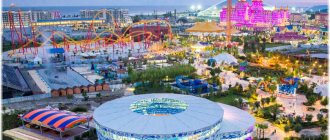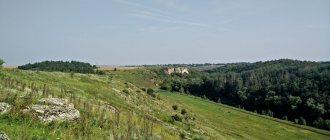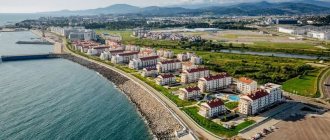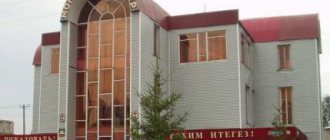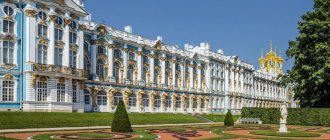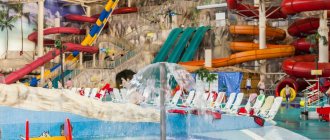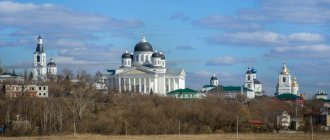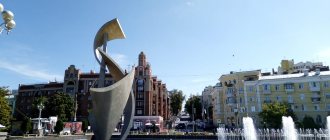Mansion E.G. Erna
Years of construction: 1900-1902.
Architect: Shcherbachev A.A. Address: Chapaevskaya, 165 Perhaps Erna's mansion is the first building in the Art Nouveau style in Samara. The decor of the building is restrained, however, the architect skillfully works with volumes and silhouettes. The graceful curve of the pediment line gives the building a modern rhythm. The only decorative element - the bas-relief of an eagle on the bay window - was destroyed during the Soviet years.
The building turned out to be quite large, in which Dr. Ern lived with his family, received patients, and rented out part of the house as apartments and doctors’ offices. During the Great Patriotic War, the building housed the Polish Embassy. On December 4, 1941, the People's Commissar for Foreign Affairs of the USSR V.M. Molotov and the chairman of the Polish government in exile V. Sikorsky here, already in a tense atmosphere, overshadowed by information about the disappearance of 15 thousand Polish officers near Katyn, signed the Declaration “On Achieving a Lasting and Just Peace.”
Houses of merchants Vasiliev and Osnovin
(Molodogvardeyskaya, 119 and 121)
Molodogvardeyskaya, 121
Molodogvardeyskaya, 119
Date of construction: ∼ 1900-1905 Architect: unknown
A small reserve of the pre-revolutionary development of Molodogvardeyskaya Street takes us back to the times when a cathedral built in the neo-Byzantine style still stood on the current Kuibyshev Square. The merchant mansions that grew up near it were also a match for him.
“The motifs of the “Russian style” are clearly visible in the 3 brick houses standing in one row. Tetrahedral tents on bay windows, pointed turrets on the corners of rhizoliths, interfloor drafts, arched window frames, masterly brickwork with pointed kokoshniks, half-columns, arches with weights - this is not a complete list of the brick decor of these houses.”
The post-revolutionary life of these foster brothers was very eventful. Thus, during the war, Vasiliev’s house housed the Norwegian Embassy, in the 1970s - an orphanage, and now future figure skating champions are forged there. And in the spring of 1920, the Provincial Police Department was located in Osnovin’s house.
Trading house S.E. Permyakova (Trading house A.N. Permyakova)
Years of construction: 1900-1901.
Architect: Zelenko A.U. Address: Molodogvardeyskaya, 70 The first building of Zelenko in the Art Nouveau style in Samara. Four wide pylons divide the facade into three parts: a central, narrower one, and wide side ones. The trunks of the pylons are decorated with large female masks entwined with waves of flowing hair, into which shells and water lilies are woven. Perhaps Zelenko portrayed the customer Permyakova herself here.
Sights of Samara on the map
On the map below we have placed all the attractions of Samara that were mentioned in the article. You can study it and follow our guide exactly. Or you can create your own route according to your taste.
Now you know what to see in wonderful Samara and which places are definitely worthy of your attention and time. You can use our guide as an aid or plan your trip entirely based on it; in any case, we hope that your trip to Samara will be interesting and unforgettable!
Best regards, BlogTravel team
- Sights of Kaliningrad - what to see in 2-3 days in Kaliningrad
Mansion A.U. Zelenko
Years of construction: 1900-1903.
Architect: Zelenko A.U. Address: Samarskaya, 179 In 1900, architect A.U. Zelenko received permission to build his own house. The construction of the mansion was completed in 1903, but Zelenko did not live a single day in it, since in 1900 he left for Moscow at the invitation of F.O. Shekhtel. The building is designed in Art Nouveau style with windows of different sizes and an asymmetrical façade. The massiveness of the walls is contrasted with the lightness of the balcony grille and metal brackets. The corner of the balcony is supported by one large limestone column. Currently, the building houses the House of Journalists and Writers.
Spiritual consistory building
(Vilonovskaya, 22)
Date of construction: 1905 Architect: Alexander Shcherbachev
Beginning in 1872, in Samara, near the cathedral under construction on the side of the current Vilonovskaya Street, a “church” cluster began to take shape. It all started with the construction of the Theological Seminary building (now Molodogvardeyskaya, 133). But the main place in it was rightfully occupied by the building of the Spiritual Consistory.
Interestingly, its initial project in the neo-Renaissance style was developed by Alexander Shcherbachev back in 1895. However, in the capital it was turned down, because all the buildings of the ecclesiastical department in those years were erected, as a rule, in the “Russian style”.
“Here you can see a spectacular stylization of Russian architecture of the pre-Petrine period. Massive walls, decor, entrance portal, high hipped roof express patriarchy and stability.”
In the early 1930s, the building was transferred to the Kuibyshev Industrial Institute. They began to call it “the educational campus on Vilonovskaya.” In the late Soviet period, the heat and power engineering department was located here. In 2005, the building was returned to the diocesan administration of the Russian Orthodox Church.
Apartment house A.F. Nuycheva (Gymnasium of the Kharitonov Sisters)
Years of construction: 1902-1904.
Architect: Kvyatkovsky M.I. Address: Samarskaya, 149 Apartment building A.F. Nuycheva became the first Samara building of M.I. Kvyatkovsky. A noticeable detail of this house is the zoomorphic ornament. These are butterflies - a symbol of the fragility and fragility of existence, and the heads of elephants supporting the bay window. The decor also includes women's masks - a symbol of eternal beauty and Atlantean figures (removed in the 1980s for restoration). The elegant forged elements in the fencing of the balconies and the canopy over the entrance also deserve attention. For a long time, this building housed the Kharitonov sisters’ gymnasium, and after the revolution, school No. 25 and a lyceum.
Pushkin People's House
Year of construction: 1903. Architect: Zasukhin F.P.
Address: L. Tostogo, 94 Public buildings were rarely built in the Art Nouveau style, but there were exceptions. One of the first public buildings in the Art Nouveau style in Samara was the Pushkin People's House. This building is characterized by minimalist facade decoration, large details, metal decorations on the gates and porch in the spirit of European Art Nouveau. Inside there was another grand staircase and the entrance to a theater hall with 775 seats. On the second floor there are several rooms for classes, and in the one-story part, to the left of the main entrance along the street. L. Tolstoy, there was a library with a reading room and a tea room. Now the building houses the Palace of Culture of Railway Workers named after. A.S. Pushkin.
Samara Olga Community of Sisters of Mercy
(Leo Tolstoy, 136)
Date of construction: 1902 Architect: Tadeusz Hilinski
In 1891, a community of sisters of mercy was organized in Samara. It acted according to the charter of the Russian Red Cross Society, which was under the patronage of Empress Maria Fedorovna (wife of Alexander III). The community, in turn, was called “Olginskaya” in honor of Grand Duchess Olga Nikolaevna (daughter of Nicholas II). The building was built using voluntary donations, and the architect Khilinsky developed the project for free. Find photos of the interiors of the Olga Community of Sisters of Mercy here.
“The peculiarity of the architecture of this building was manifested in the richness of details: the white stone frames of the windows on each floor have their own design <...> the side projections were completed with faceted domes, and the center of the building was a low belfry with a dome. The first floor and corners of the building are heavily rusticated.”
In 1937, the building of the Olga community of sisters of mercy was built up to three floors. It is worth noting that the reconstruction was carried out, trying to preserve the style of the building, which was generally successful.
Mansion A.P. Kurlina
Years of construction: 1900-1904.
Architect: Zelenko A.U. Address: Frunze, 159 Mansion of the merchant of the 1st guild A.G. Kurlin and his wife A.P. Kurlina became one of the first buildings in Samara in the Art Nouveau style. The mansion was decorated with the street. Saratovskaya (now Frunze Street) with its facade with a front door decorated with mirror glass and curls of black metal. According to legend, the mysterious profile of a woman’s head on the pediment resembles the mistress of the mansion herself. On the street Alekseevskaya (now Krasnoarmeyskaya Street) house attracted the eye with its openwork butterfly gate, balcony and large dragonfly made of forged metal on the roof.
In 1995, the mansion became a monument of historical and cultural heritage of federal significance. Since 2012, the Modern Museum was opened in Kurlina’s house.
Temple of the Sacred Heart of Jesus
(Frunze, 157a)
Date of construction: 1906 Architect: project - Foma Bogdanovich, supervision of construction work - Alexander Shcherbachev
The quintessence of the Gothic style in the architecture of Samara and, together with the modern Kurlina mansion and the constructivist Radio House, is one of the most “postcard” views of the city. Construction of the church began in 1902 and cost 80,000 rubles.
“Gothic, or rather the passion for Gothic, is developing as an independent architectural movement in line with the general stylistic searches characteristic of the turn of the 19th-20th centuries.
The main entrance is a series of pointed arches, located one after another and recessed into a brick wall <…> A white twisted column with a capital rises above the entrance. Like a spring, it enhances the upward tendency and emphasizes the axis of symmetry.
The façade is flanked by slender, tall towers. They are integral to the image of a Gothic cathedral. <…> Frozen calm is alien to the Gothic. Her style is soaring, vertical. Horizontal development is kept to a minimum. The faceted pilasters of the turrets end with pointed helmets.”
In January 1930, a Polish-German club was opened in the church. And its longest “tenant” during the Soviet period was the local history museum, which was located here from 1941 to 1991, after which the temple was returned to believers.
It wouldn’t be a bad idea to look into the church courtyard. There you will find a two-story chapel - a Catholic prayer house built back in 1887. Before the church was built, services were held there, and a priest lived on the second floor.
Mansion P.I. Shikhobalova
Years of construction: 1903-1905.
Architect: Shcherbachev A.A. Address: Ventseka, 55 Built by a wealthy representative of the young Samara bourgeoisie - P.I. Shikhobalov. In the development of the project, in addition to A.A. Shcherbachev was attended by Samara architect G.N. Moshkov. Only the façade of the main building faces Ventsek Street, which is decorated with pediments and flowerpots in the upper part. The windows are rectangular in shape, on the ground floor they are larger in size, here the typical thrust of Art Nouveau towards large areas of glazing is manifested. The balcony above the arch was supported by atlases, which for a long time were the hallmark of the house, but in 1993 they were removed for restoration. During the Soviet years, the building was occupied by the NKVD, and then by a military tribunal.
What to see and where to go in Samara - day 2
On the second day of your trip around Samara, you will be able to see the most interesting and unusual sights of the city. It is filled with fascinating museums and beautiful parks. Fans of active recreation can head to the Country Park, Yuri Gagarin Park, Samarskaya Luka National Park or the Mastryukov Lakes. In addition, the city has places for cultural recreation.
For example, tourists are recommended to visit the museum and exhibition house museum of M.V. Frunze, the museum-estate of the writer Alexei Tolstoy, the Samara Regional Art Museum, the Samara Academic Drama Theater named after M. Gorky, the Samara State Philharmonic Society, the Samara Academic Opera and Ballet Theater. In this city, you can go to the Samara Oceanarium with your children, and with friends visit the Zhigulevsky Brewery or the Stroikov and Yakimov Flour Mill.
Samara Academic Drama Theater named after Gorky
Samara Academic Drama Theater named after Gorky
The Samara Academic Drama Theater named after M. Gorky is one of the oldest drama theaters in Russia. It was founded in 1851. The theater troupe supports the traditions of the Russian stage. The theater's productions receive high marks at competitions and festivals.
The theater occupies a building that was built in 1888. It is made in pseudo-Russian style. The theater's repertoire includes plays and musicals. While in Samara, be sure to visit the drama theater. In it you will definitely be able to enjoy real art.
Zhigulevsky brewery
Zhigulevsky brewery
Zhigulevsky Brewery is an enterprise that produces the famous “Zhigulevskoe” beer. The plant would have been built in 1881. It is one of the largest in the country.
The Zhigulevsky plant is one of the most visited attractions in Samara. The ancient building in which the brewery is located is a monument of urban planning, architecture and an object of cultural heritage of Russia. This attraction will definitely leave behind a pleasant impression.
Museum and exhibition
Museum and exhibition
The museum and exhibition building was built in Samara in 2007. Soyuz launch vehicles are produced here. They are the ones who launch satellites and manned spacecraft into low-Earth orbit.
The center's museum collection displays models of spaceships, satellites, instruments and engines. Another part of the exhibition tells visitors about the astronauts and their orbital everyday life. There are also shops here where tourists can find souvenirs for every taste.
Country park
Country park
The country park was opened in the city in 1932 on the territory of a former merchant estate. It covers an area of 42 hectares. The country park is recognized as a natural monument of local importance. It is also the largest in the city.
Centenary oak trees grow in the park, there are attractions and cafes. Anyone can visit the riding school. In winter, a piste opens here for skiers and snowboarders. This place is perfect for a walk with family or close friends.
House-Museum of M.V. Frunze
House-Museum of M.V. Frunze
House-Museum of M.V. Frunze was created in 1934. It is located in the building in which M.V. Frunze lived and worked in 1919. The house-museum is a branch of the regional museum of history and local lore. This one-story brick building is recognized as a monument of residential architecture.
The exhibition of this museum tells visitors about the events of the Civil War. There is an exhibition with documents that were classified for a long time. This place is perfect for people who are interested in history.
Museum-estate of the writer Alexei Tolstoy
Museum-estate of the writer Alexei Tolstoy
The museum-estate of the writer Alexei Tolstoy was opened in 1983 in honor of the 100th anniversary of his birth. The writer spent his childhood and youth in this house, and here he wrote his first works. In Samara, Alexey Tolstoy studied at the school. Today, the building in which the museum is located is recognized as a cultural heritage site.
The museum's exhibition consists of the writer's archive, which includes letters, books, photographs, and diaries. Here you can see antique furniture, dishes, clothes, etc. The museum will be interesting to visit with friends or family. During the excursion you will be able to learn a lot of new and interesting things from the life of Alexei Tolstoy.
Samara Regional Art Museum
Samara Regional Art Museum
The Samara Regional Art Museum was founded in 1897. The basis of the museum's collection are paintings by local artists that were created in the 19th and 20th centuries, as well as works by Russian artists of the early 20th century. The art museum is located in the center of Samara. It occupies one of the most beautiful buildings in the city.
This place is perfect for art lovers. In the museum you can view paintings by Shishkin, Repin, Serov and others. The museum’s collection includes more than 35 thousand paintings that every tourist can see with his own eyes.
Yuri Gagarin Park
Yuri Gagarin Park
Yuri Gagarin Park was opened in Samara in 1976. It is located in the very center of the city. This park is equipped with everything necessary for a comfortable and pleasant stay. There is a pond, attractions, a recreational area, sports grounds, a stadium and a cafe where you can try local cuisine.
The park hosts holidays, cultural events, and folk festivals. You can visit it with family or friends. The park will pleasantly surprise you with its beauty, Ferris wheel and vibrant landscapes.
Samara Oceanarium
Samara Oceanarium
The Samara Oceanarium is located on the first floor of the Moskovsky shopping and entertainment complex. Here visitors can see more than 4 thousand representatives of the seas, oceans and lakes. All the inhabitants of this place were bred in captivity. The animal enclosures of this aquarium are designed in such a way that they resemble the natural environment.
In the aquarium you can watch how the life of sea inhabitants goes. Visitors can expect turtles, sharks, waterfowl and even penguins. In addition, at the aquarium you can listen to lectures about marine life.
Samara State Philharmonic
Samara State Philharmonic
The Samara State Philharmonic was opened in 1940. The Philharmonic Hall has a capacity of 975 spectators. Its bill includes performances by touring performers as well as local bands. For example, here you can listen to an ensemble of Russian folk instruments, symphony and chamber orchestras.
This place is perfect for lovers of classical music. The Philharmonic is very popular among both locals and tourists. Here you can also see the organ, which was installed in 2001.
Samara Academic Opera and Ballet Theater
Samara Academic Opera and Ballet Theater
The Samara Academic Opera and Ballet Theater occupies a monumental gray building located on Kuibyshevo Square. This building is made in the neoclassical style. The large hall of the theater can accommodate 1144 spectators, the small hall - 180.
At the Opera and Ballet Theater you can watch classical productions and avant-garde performances. His poster consists of ballets, operettas, concert programs, etc. In addition, the theater hosts classical music and dance festivals.
Flour mill of Stroikov and Yakimov
Flour mill of Stroikov and Yakimov
The flour mill of Stroikov and Yakimov was built in the city in 1903 according to the design of the architect A. A. Shcherbachev. It is located in a building whose facade is made in pseudo-Russian style. In 1987, the mill building was recognized as a monument of regional significance.
This is a very interesting and unusual place. The building attracts the attention of tourists with its unusual architecture. Today, the enterprise is still operational, so this attraction can only be seen from the outside.
Mastryukov Lakes
Mastryukov Lakes
Mastryukovsky lakes are a natural complex located between Samara and Tolyatti. There are picturesque reservoirs and plants listed in the Red Book. Rare animals live on the territory of the complex, which tourists can see with their own eyes.
Mastryukovsky lakes are ideal for fishing lovers. The lakes are home to various types of fish. This place is created for relaxation with the family. In addition, you will be able to attend festivals that take place on the territory of the natural complex.
Samarskaya Luka National Park
Samarskaya Luka National Park
Samarskaya Luka National Park is located in a bend of the Volga. The Zhigulevsky Nature Reserve is located on its territory. Part of the national park is a closed natural area, the other part is open to the public. The park also contains the Zhiguli Mountains.
In the National Park you can go on a trip on yawls and kayaks, visit the House-Museum of the poet A. Shiryaevets, which is located in the vicinity of Samarskaya Luka. This place is perfect for walking in the fresh air. Here you can take bright and colorful photographs that can preserve the memories of this trip.
Restaurant "Aquarium"
Years built: 1900s.
Architect: Kvyatkovsky M.I. Address: Samarskaya, 95 This building is a manifesto of strict and rational modernity. Its peculiarity is the layout of laconic, strict, multi-storey volumes placed on a high base. The bay window of the central volume was crowned with a single decorative element - a metal structure imitating a dome. The expression of the Art Nouveau style here is not ornamentation, but smooth curved lines growing out of the plane of the wall, the multi-volume nature and rhythm of the building. The Aquarium restaurant belonged to the famous Ivanov brothers in Samara and was famous for its gypsy choir. After 1917 the building was nationalized. In Soviet times, the Theater of Young Spectators was located here.
Theater-circus "Olympus"
Year of construction: 1907. Architect: Shamansky P.V.
Address: Frunze, 141 Now on the site of “Olympus” stands the Samara Philharmonic. In the 1980s The old building was demolished due to its unsafe condition, and a new one was built in its place. The author of the project was Yu.V. Temples He took the appearance of the old building as a basis, moved it 15 meters from the red line, and added usable space. The original building was decorated with Art Nouveau elements: women's heads, bas-reliefs of winged pegasuses, sculptures of characters from Greek mythology, balconies with openwork lattice and curved windows and doors. Most of the decorative elements of the Olympus Circus were copied by Yu. Khramov and transferred to the facade of the new building.
House of merchant Sidorova
(Chapayevskaya, 87)
Date of construction: 1904 Architect: Georgy Moshkov
At the time of construction, it was one of the tallest buildings in Samara. As Vahan Karkaryan writes, this building showed an unusual innovation by the architect Moshkov - the use of arcades of Byzantine temples in the design of residential buildings. For example, the base of the dome is designed in the form of an arcature belt and a number of elongated arched windows.
Mansion V.M. Suroshnikova
Year of construction: 1907 (?).
Architect: Shcherbachev A.A. (Shekhtel F.O.). Address: Tolstoy, 41 The history of the construction of this mansion is shrouded in mystery. Its author has always been considered A.A. Shcherbachev (as his friend K.P. Golovkin claimed), however, archival research by art historians suggests that the author of the original project was the famous Moscow architect Fyodor Shekhtel. The architecture of Suroshnikov’s house shows a clear influence of strict “northern modernism”. A varied range of finishing materials, characteristic of Art Nouveau, is used: natural stone, blue tiles, grained plaster. The corner balcony is reminiscent of the balcony of the right tower of the Yaroslavsky railway station in Moscow, designed by F.O. Shekhtel.
Dacha K.P. Golovkina
Years of construction: 1908-1909.
Architect: Golovkin K.P., Tepfer V.V. Address: Soviet Army, 298 Konstantin Golovkin was a merchant, artist, archaeologist, philanthropist, traveler, member of the City Duma and self-taught architect. He, together with his friend Valentin Tepfer, designed a building that to this day remains the most mysterious building in Samara. The dacha is located on the slope of a hill. From the Volga, 3 volumes are clearly visible, cut through by narrow windows. In front of the entrance to the building there is a sculpture of a girl emerging from the Volga wave, and in front of the facade there are two elephants mounted on a retaining wall made of stone. Thanks to these stone animals, the popular name “Dacha with Elephants” was assigned to Golovkin’s dacha.
Sights of Samara
Samara can become an ideal place for a family or active holiday. Here you will not encounter many tourists and stand in queues. Samara will allow you to enjoy unique architectural monuments, natural attractions, museums and theaters. You will definitely walk around the entire city on foot, looking at the beautiful embankment, narrow and atmospheric streets and beautiful landscapes that await you at every step.
This material will introduce you to the sights of Samara, allowing you to make a first impression of this city and plan your trip. With its help, you will know exactly which places are worth visiting and how to get to your desired destination. This way your trip will definitely be successful.
- Samara embankment, Iversky Convent, Intercession Cathedral;
- Kuibyshev Square, Glory Square, Leningradskaya Street, Samara Boat Monument;
- Ascension Cathedral, Roman Catholic Parish of the Sacred Heart of Jesus;
- Observation deck "Helicopter", Strukovsky Garden, Stalin's Bunker, Country Park;
- Zhigulevsky Brewery, Museum and Exhibition;
- Frunze House-Museum, Museum-Estate of the writer Alexei Tolstoy, Samara Regional Art Museum;
- Samara Academic Drama Theater named after M. Gorky, Yuri Gagarin Park, Samara Oceanarium;
- Samara Academic Opera and Ballet Theater, Stroikov and Yakimov Flour Mill;
- Shiryaevo, Zolnoye, Mount Strelnaya, Blue Lake, Russian Selitba;
- Buzuluksky pine forest, Racheisky pine forest, “Racheisky Alps”, Cave of the Greve brothers;
- House with Elephants (Konstantin Golovkin's Dacha), Samara State Philharmonic;
- Mastryukov Lakes, Samarskaya Luka National Park, Kamennaya Zoya;
In order to make it convenient for you to navigate where all these places are located and how to get to them more conveniently, at the bottom of the article there is a map with the sights of Samara, which is marked with descriptions.
Warehouses N.V. Meshkova
Year of construction: 1909. Architect: unknown.
Address: M. Gorkogo, 98 Meshkov's warehouses are an example of an industrial and warehouse complex built in the Art Nouveau style. Samara at the beginning of the twentieth century. was a rapidly growing city. There was a need for storage and sale of large quantities of building materials. It was for this purpose that the merchant Meshkov built this complex. The design actively used the latest material for that time - reinforced concrete. Thanks to it, the silhouette of the main facade resembles a river wave and is in harmony with the opening view of the Volga expanses. Unfortunately, the author of the project is not known, but it is known for sure that the construction was carried out by a St. Petersburg company specializing in reinforced concrete buildings.
How to get to Samara
Flights to Samara
Samara Hotels
There are three ways:
- The plane ride takes about one and a half hours. Landing at Kurumoch airport named after. Sergei Korolev, located in the village of Bereza (35 km north of Samara, 45 km east of Tolyatti). There are buses and minibuses from Kurumoch airport, but they run quite rarely. The best option to get to the city center is to take a taxi or car sharing.
- By train from Kazansky station in Moscow. The drive takes 13 hours (on the fastest route to Samara). Upon arrival, you will see a modern building made of glass and concrete in the form of a skyward pyramid. The railway terminal was put into operation in 2000 and so far it is the highest station complex in Europe (height with spire - 101 m). At a level of 95 m there is an observation deck. You can get your bearings and plan a route.
- River cruise Moscow - Samara. A great summer adventure lasting 5-6 days. The Samara river port has connections with six seas and accepts ships of any class, including river-sea.
Volzhskaya embankment in Samara
If you find yourself in Samara using method No. 3, then when you go ashore, don’t waste time, start exploring the city from the promenade along the Volga embankment.
Breathe in the free river air, hear the bass whistles of motor ships over the mighty expanse, look around the vast expanse of the Central Russian Plain lying in front of you, remember how many glorious events took place on these banks. Perhaps it will be easier for you to immerse yourself in Russian history and understand the motives of the mysterious Russian soul.
Samara embankment is one of the longest on the Volga. Modern and restored, the real “face of the city.”
In summer, citizens and guests of the city sunbathe on equipped beaches. And when you get tired of basking in the sun, go on a bicycle or an electric scooter. The city is equipped with bicycle parking near all significant tourist sites.
The embankment along the entire city is equipped with piers and landing stages. In summer, numerous “water buses” run from them. On a hot day, take a ride to the Samarskaya Luka State Natural National Park.
View of the Volga near Samara
Novokreshchenova's mansion
Year of construction: 1909. Architect: Kvyatkovsky M.I.
Address: Frunze, 144 This mansion is an example of sophisticated elite modernism. The decoration of the façade is dominated by floral motifs - these are orchids, which with their long curved stems entwine the building and, rushing upward, bloom on its cornice. A sophisticated viewer will immediately note that these orchids are very similar to those that decorate the Bristol-Zhiguli Hotel. Flowers are a kind of “calling card” of the architect Kvyatkovsky, whose surname, by the way, is derived from the Polish word “kvyat” - flower.
Apartment building P.P. Golovkina
Year of construction: 1910. Architect: P.P. Golovkin.
Address: Leningradskaya, 22 The architect of the building was the owner of the house himself, the younger brother of Konstantin Golovkin, Peter. He received his art education in Moscow. This building contains recognizable elements of the Art Nouveau style. This includes bold work with ornaments, a choice of decorative materials, an abundance of volumes, bas-reliefs with women’s heads, and forged balcony railings. However, the symmetrical facade of the building is rather atypical for Art Nouveau. The owner spent 19,000 rubles on building the house, which was a fabulous sum at that time. Most of these funds went to furnishing the interiors. Most likely, part of the internal space was rented out for shops.
St. George's Lutheran Church
(Kuibysheva, 115-117)
Date of construction: 1865 Architect: designed by engineer Nikolai Eremeev, it was redesigned by architects from St. Petersburg
Initially, the church building was built for the Catholic community of the city. The main “instigator” in this case was the Samara merchant Yegor Annaev. When the temple was almost ready by 1864, an uprising occurred in Catholic Poland, which was part of the Russian Empire at that time. As a result, with the consent of Yegor Annaev, the building was transferred to the Lutheran community of the city.
“This is the main dominant feature of the main street. Without this vertical, the church bell tower, the street perspective would be hopelessly monotonous.”
The church building was illuminated on September 26, 1865. 12 years later it was practically destroyed by a huge fire. It took 6 years to restore the church. But every cloud has a silver lining, and it was then that she acquired side wings.
Like the church, the church was closed in January 1930. However, she had a much longer list of “tenants”. Starting from the “Union of Militant Atheists” of the 1930s, ending with the workshop of monumental sculptors. In the first list of historical and cultural monuments in 1966, it was listed as “Workshop of the Union of Artists. Gothic".
On December 21, 1991, in the church, despite the fact that restoration and repair work had not yet been completed and the heating was not working, the first Christmas service was held after a 60-year break.
Hotel "Bristol-Zhiguli"
Years of construction: 1870-1879;
Reconstruction: 1911. Architect: Kvyatkovsky M.I. Address: Kuibysheva, 111 The building in the classicist style with a symmetrical, strict facade was built in 1879. A few years later, the hotel of the Ivanov brothers was opened in it, which existed until 1907. Then the house was occupied by another, even more luxurious hotel - the Grand Hotel " Especially for its opening M.I. Kwiatkovsky reconstructed the building in the Art Nouveau style. The architect turned to the idea of ornamentation, and this is where his “signature” floral decor is born. Orchids decorated not only the facade, but also the interiors of the building.
Kwiatkowski worked actively with form, giving the three balconies on the second floor a natural, streamlined look. During the Civil War, the headquarters of the Samara Rifle Division was located here, and during the Great Patriotic War, the representative office of the Committee for the National Salvation of France was located here.
Trading house Shchetinkina P.V.
Year of construction: 1914, reconstruction: 1932. Architect: Ushakov-Reshetnikov Ya.S.
Address: Molodogvardeyskaya, 67 In 1876, Kazan merchant Pavel Vasilyevich Shchetinkin opened a branch of his partnership “P.V. Shchetinkin in Kazan" for the sale of haberdashery goods and furs in Samara. At first he rented premises in apartment buildings, but in 1913 he began construction of a personal building for a trading house on the corner of Sobornaya and Predtechenskaya streets. The construction, which was completed in 1914, was headed by the self-taught architect Yakov Stepanovich Ushakov-Reshetnikov. In 1932, the building was added three floors by architect S.K. Efremov.
The building has a symmetrical composition with alternating volumes of different heights. The rhythmic pattern of the facades is determined by the alternation of wide showcases, window openings and narrow openings covered with hog tiles. The center of the building’s composition is a two-story corner bay window, which before reconstruction was topped with a hipped roof.
A little history
Did you know that Russia has its own analogue of the Great Wall of China?
It's time to learn and be surprised at the scale with which the Russians had to defend themselves from the raids of the steppe peoples: the Bashkirs, Nogais and Kalmyks. The Zavolzhsky historical rampart is a system of ancient fortifications, XIII century. The total length of five-meter earthen embankments and ditches is more than 2000 km. The beginning of this protective wall is the current Samara region, the end is the foothills of the Middle Urals. The cyclopean structure has been completed and remodeled, supplemented and rebuilt over the centuries.
Serif
Beautiful Samara, erected by decree of Tsar Fyodor Ioannovich in 1586, was one of the fortresses in the structure of these defensive structures.
For the construction of the fortress, Prince Grigory Zasekin chose a place on the high left bank of the Volga. Natural protection from the steppe was provided by the mouth of the Samara River. The fortress was located just south of the former Valve Factory. Today, neither the plant nor the ancient fortress walls remain, but in honor of the 400th anniversary of Samara in 1986, on the corner of Kutyakova and Vodnikov streets, a fragment of historical buildings and a log house imitating one of the towers were recreated. There is a memorial plaque on the wall. Nearby there is a monument to the founder of the city.
The monument to Prince Grigory Osipovich Zasekin, the first governor of Samara, was erected in 2014. It is located at the end of the Field Descent, on the Volga embankment, along the banks of which Zasekin founded three fortresses: Saratov, Perevolokh (Volgograd) and Samara.
Samara boat
Another monument built in honor of the 400th anniversary of the city (architects: Anatoly Yankin and Igor Galakhov).
The Samara boat is a symbol of the ancient history of the Volga region
The Samara boat is a massive concrete composition on the Oktyabrskaya embankment. A twenty-meter snow-white boat, with its nose pointed towards the Zhiguli Mountains, personifies the ancient history of the region, when the canoes of Russian knights and merchants majestically sailed along the Volga. Samara in those days was the main river port and the largest fair of the Moscow kingdom.
The Samara boat is one of the symbols of the city, regularly appearing on postcards and souvenirs. A great place for a photo shoot with a view of the Volga.
In those days, there were essentially no other means of communication. And Samara, built on the main waterway leading to the center of Russia, is quickly becoming a center of trade and shipping.
The prosperous city attracted adventurers of all stripes. The main events of the 17th–18th centuries were peasant riots led by Stepan Razin and Emelyan Pugachev. By the way, Samara residents greeted both chieftains with bread and salt and the ringing of bells.
There are not many echoes of these events in the city. Here are just a few toponyms:
- The Pugachevsky tract is an ancient road leading to the city of Pugachev (formerly Nikolaevsk), where in the Mechetnaya Sloboda the fugitive Yaik Cossack Emelyan, Ivan’s son, declared himself Tsar Peter III and moved his scattered regiments through Samara to the center of Russia.
- Stepan Razin Street (at different times Simbirskaya, Zemlyanaya, Voznesenskaya). Old city. If you move up Razin, then in ten minutes you will find yourself on the Samara “golden mile” - the largest concentration of historical monuments. And on this street you can look into the oldest surviving cathedral in Samara - Voznesensky. Here in 1897, the wedding of the young journalist of the Samara Newspaper, Alexei Peshkov (Maxim Gorky), took place with the proofreader of the same newspaper, Ekaterina Volzhina.
Public meeting building
Year of construction: 1914. Architect: Werner D.A.
Address: Kuibysheva, 157 In 1911, the Public Meeting of government officials and public organizations decided to build their own building with the goal of “providing its members and their families with the opportunity to spend time with convenience, benefit and pleasure.” Balls, masquerades, literary evenings, dramatic performances, scientific lectures were held here, and there was a library.
The three-facade building was designed and built by Dmitry Aleksandrovich Werner. All three facades are unique and do not repeat each other in any way. The central window of the facade from Kuibyshev Street is decorated with a male mask, whose hair flows in smooth lines onto the neighboring windows. Above the central entrance group there is a uniquely shaped dome, which was previously decorated with stained glass.
House of Lineva-Rozina
(Kuibysheva, 44)
Date of construction: 1901 Architect: Filaret Zasukhin
The intersection of Pionerskaya and Kuibyshev streets attracts attention with the presence of two beautiful buildings that pleasantly complement each other. Along the odd side of the pre-revolutionary Dvoryanskaya Street stretches the Samara “office” of the Russian Commercial and Industrial Bank. At the turn of the 19th and 20th centuries, its façade acquired a modern look. The famous architect Alexander Zelenko transformed the standard project into an example of the “Old French” style.
Their neighbors on the even side decided to keep up and ordered the reconstruction of their two-story house in the “German” style (as Gothic was called in pre-revolutionary Samara). The author of the reconstruction was the famous Samara architect Filaret Zasukhin.
Mansion N.S. Zhogoleva
Years of construction: 1910s.
Architect: Moshkov G.N. Address: Galaktionovskaya, 57 The only Art Nouveau building in Samara, in which the influence of Baroque can be traced. The building seems rather squat, which is largely due to the architect’s rejection of the typical Art Nouveau “showcase windows.” Art Nouveau here reveals the asymmetrical façade, an abundance of smooth curves and women's heads in the ornament. Once upon a time, the bay window on the right side of the building, forming the second corner facade, was crowned with a dome, similar to the dome above the entrance projection.
What to see in the vicinity of Samara
If you cannot find interesting sights in Samara, you should go on a trip to the outskirts of the city. Here tourists will find unique natural attractions. During the trip you can see such places as Shiryaevo, Zolnoye (Mount Strelnaya), Blue Lake, Buzuluksky Bor, Racheisky Bor (“Rachei Alps”), Cave of the Greve Brothers, Russian Selitba.
Shiryaevo
Shiryaevo
Shiryaevo is an excellent route for tourists who like to spend their weekends away from the hustle and bustle of the city. This place is filled with interesting sights. For example, in Shiryaevo there are mountains, adits, a Stone Bowl, and a Wine Spring.
Shiryaevo greets tourists with incredible landscapes and colorful nature. If you don't know how to spend time with your friends or family, you should definitely include this item in your itinerary. In addition, in Shiryaevo you will take beautiful pictures as a souvenir.
Zolnoye – Mount Strelnaya
Zolnoye – Mount Strelnaya
Mount Strelnaya is the main attraction of the village of Zolnoye. Its height is 351 meters. In the past, this mountain served as an observation point for the robber patrol of the Volga freemen. Today there is an ecological trail here, which is popular among tourists.
This place is perfect for active recreation. During your trip to the mountain you will be able to enjoy beautiful views of the local nature and breathe fresh air. Such a trip will definitely leave behind the most vivid and pleasant memories.
Blue Lake
Blue Lake
Blue Lake is a monument of regional significance, located near the village of Staroye Yakushkino. This lake has an interesting feature: it never freezes and maintains a temperature of +7℃. The water in it is very clean and transparent, but there is no life in it. The lake attracts the attention of tourists with its beauty. It is perfect for traveling with friends or loved ones. You can also take bright and unusual pictures here.
Buzuluksky pine forest
Buzuluksky pine forest
Buzuluksky pine forest is located near the city of Buzuluk, almost on the very border with the Orenburg region. It is a pine forest that grows in a large basin near the Borovka River. The territory contains relict pine trees and is home to wild boars, roe deer, badgers, beavers, etc.
This is a very beautiful place that is worth visiting while traveling around Samara. Here you will be greeted by trees aged from 300 to 350 years, fresh air and beautiful scenery. Not far from the forest there are recreation centers where tourists can stay.
Racheisky Bor. "Racean Alps"
"Racean Alps"
The “Rachei Alps” are rocks that are located in the Rachei Forest. They are stone slabs of sandstone, which are up to 15-20 million years old. Not far from them are the Rachei boulders - a direct legacy from the Ice Age.
This place is perfect for a walk in the fresh air. Here you can have a picnic and enjoy your holiday in the company of interesting people. The nature of Racheysky Bor will surprise you with its beauty and colorfulness.
Greve Brothers Cave
Greve Brothers Cave
The Greve Brothers Cave is a natural landmark of historical significance. It was found by the sons of a German pharmacist, in whose honor the landmark got its name. The caves here are very large, but moving through them is difficult, as you have to crawl on all fours and climb.
This place is not suitable for families with children. However, you can definitely go here with your friends. The cave is located in a very picturesque place. Here you can enjoy the natural beauty of the Samara region.
Russian Selitba
Russian Selitba
Russian Selitba is an eco-village located among mushroom forests and holy springs. This place is the center of local rural tourism. Many tourists come here to spend their holidays or weekends in silence.
Russian Selitba will greet you with bright nature and fresh air. You will be able to chat with friendly locals and be away from the bustle of the city. This place is perfect for a family holiday.
Cinema "Furor"
Years of reconstruction: 1914. Architect: Kotov G.I.
Address: Sadovaya, 231 The building belonged to M.E. Antonov, in 1914 he decided to reconstruct it in the Art Nouveau style. The project was taken up by Muscovite Grigory Ivanovich Kotov. The architect tried to avoid eclecticism and borrowing from past styles and tried to embody pure late modernism in his construction. However, the building is richly decorated with stucco decoration. His calling card was the green “boar” - a facing tile that was very popular in Samara buildings at the beginning of the 20th century.
